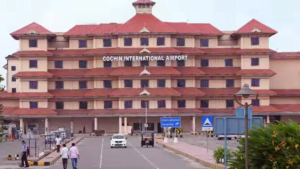CIAL Unveils New Smart Gates: Complete Your Immigration in Just 20 Seconds
Cochin International Airport Limited is soon going to introduce smart gates for the self-authentication of international travellers who are at present undergoing an immigration process that will be cut down to 20 seconds. Following its successful implementation at Delhi International Airport, the CIAL would be the country’s second airport to adopt this advanced technology under the Ministry of Home Affairs Trusted Traveller Programme. Easy Immigration with Smart Gates Into the state-of-the-art facility likely to get operational by August 2024, CIAL has already launched an infrastructure revamp at the immigration area and reserved eight lanes for biometric e-gates. The smart gates will allow international travellers to independently complete their immigration process in just 20 seconds. This innovative feature will streamline the process, minimizing long queues and significantly cutting down wait times. Fast Track Immigration-Trusted Traveller Programme (FTI-TTP) The Fast Track Immigration-Trusted Traveller Programme by the MHA is a programme designed for fast-track immigration clearance of eligible Indian nationals and foreign nationals who are OCI cardholders. The traveller has to undertake one-time registration on the MHA portal, upload the required documents, and enrol biometrics—fingerprints and face image—at the Foreigner’s Regional Registration Office or at the Help Desks set up in the immigration area, as per CIAL. How It Works After verification through the mobile OTP, visitors can use the smart gates to skip the normal immigration queues. They will self-scan their passports and do face recognition to clear immigration without any human intervention or fact-checking. The process is, therefore, fast, safe, and seamless. Infrastructure and Implementation CIAL is extremely proud to collaborate with the Bureau of Immigration in facilitating fast-track biometric smart travel at our immigration counters,” remarked CIAL Managing Director S. Suhas, IAS. “We realise the power of a seamless, hassle-free travel experience and deploy state-of-the-art technology at every possible passenger touchpoint.” The biometric authentication procedure will decrease the immigration verification time from the current four minutes to just 20 seconds.Having assumed a strategic role as the fourth busiest airport in India for international passenger traffic, with an annual throughput of 10 million passengers and 70,200 air traffic movements, handling this additional passenger load with smart gates is going to significantly improve CIAL’s passenger throughput and satisfaction. Other Modernization Initiatives Apart from the smart gates, the CIAL had, over the past few days, launched the Digiyatra facility developed in-house by its IT team. A string of modernization projects, including the Perimeter Intrusion Detection System, are planned and are likely to be commissioned next month. The fast-track immigration gates would be deployed this week, with testing starting on Monday and an official launch by August 2024. Conclusion In other words, the CIAL smart gates for self-immigration will be a welcome feature of the modernization of airports in India. Equipped with state-of-the-art biometric technology, CIAL will provide speedy, secure, and seamless immigration for fliers from across the world. This will demonstrate the effort of CIAL toward strengthening passenger experiences and continuing to be a leader as an international airport.










